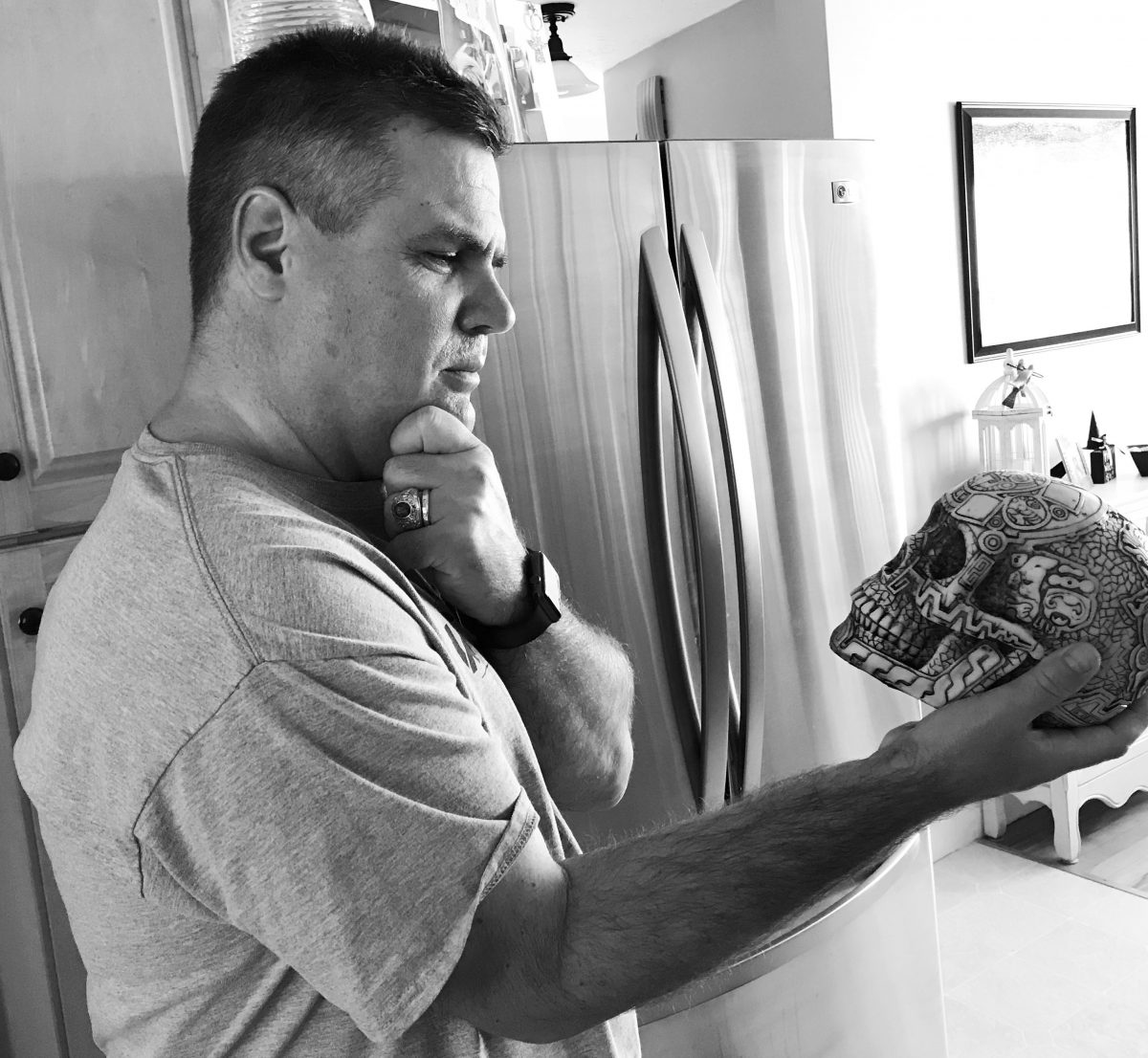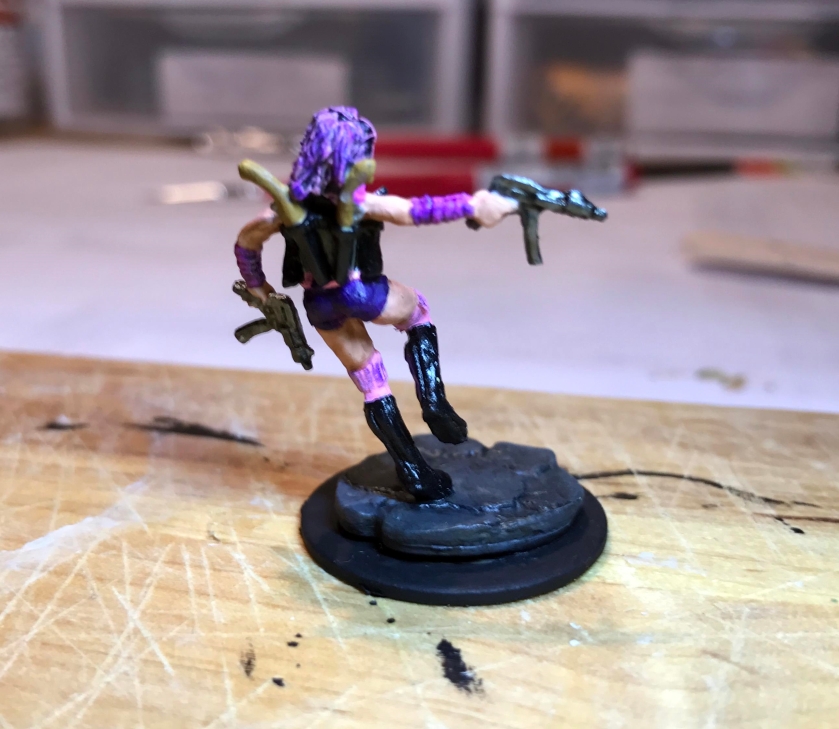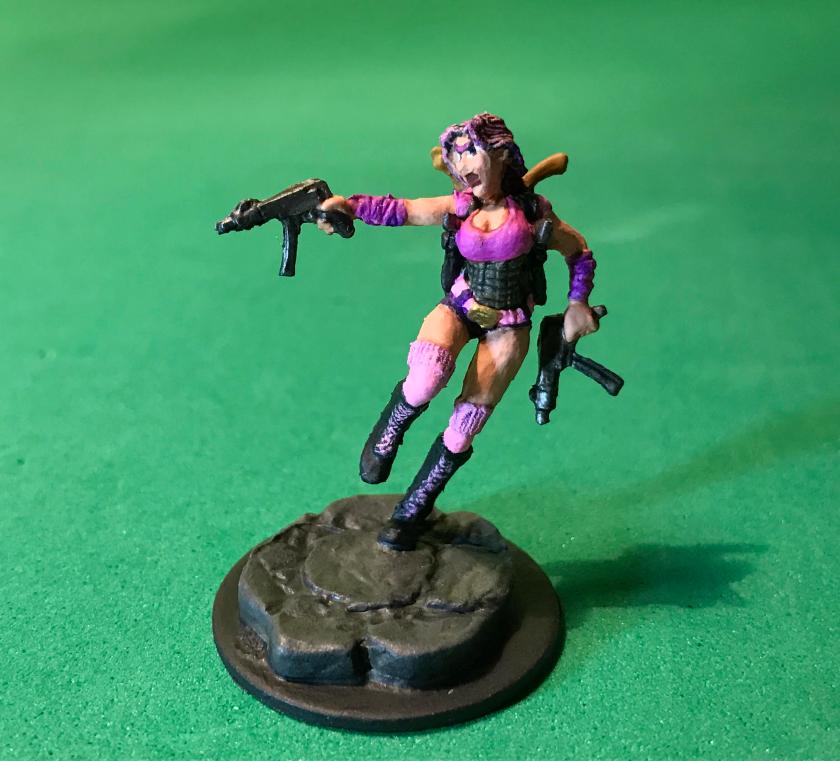This was a very large project that ended up with producing a 45-figure platoon. I hope that you find this story interesting, if only to see the determination I had to have to see this through! I am going to give some background, and then show the photos for the finished unit. After that, I will give a detailed description for my fellow hobbyists as to how I completed the various aspects of this unit – this will allow you to see the final product earlier in the blog – and those who want more details can go past the completed photos to see more detail.
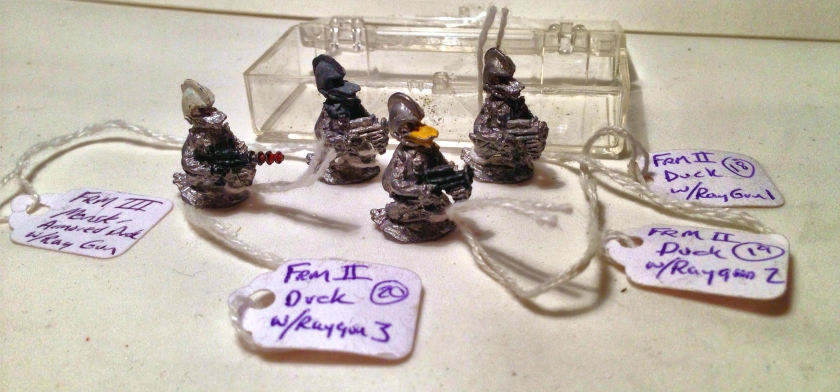

Background
I first saw the Archive Star Ducks (#2002) and Duck Vader (#2326) on the Lost Minis Wiki as I was researching some other Archive Star Rovers figures. These were made by Archive between 1977 and 1981 or so. They are made of lead and tin alloy. These were sculpted by Nevile Stocken. He sent me the drawing below via Facebook Messenger.

The rights to some of Archive’s figures have been sold off a few times. Several have been reproduced, but they are not currently in production. I searched through eBay, and these are very hard to find. I did manage to find only 4 Star Ducks and one Duck Vader, but that paltry number does not make a unit. My stretch goal was to create a platoon for use with Buck Surdu’s Combat Patrol™ system for tabletop skirmish gaming. I thought that I would need about 40 or more figures to make the unit, and I ended up with 45, which is a good size for a traditional platoon. In this process, I ended up making a mold and casting 40 for myself and some for Buck as previously described in this blog and Buck’s. I converted 4 Squad Leaders with War Games Supply Dump retro sci-fi weapons – which I was lucky to get as WSD closed on March 31st, 2017. I converted 6 figures to make up the mortar crew, to include making the mortars, ammo boxes, and mortar rounds. I also converted three figures to make up an Anti-Tank section (now known as the Bazookaducks) by arming them with Reaper Chronoscope bazookas.
Platoon Organization
The platoon is composed of 45 figures as described below. Five of the figures, including the platoon sergeant and the platoon leader are original castings. The remaining 40 are all Star Ducks that I cast over the last year.
Star Duck Platoon
- Platoon leader – Duck Vader (1)
- Platoon Sergeant (1)
- Duckfoot Mortar Section (6 figures)
- Mortar Crew 1 (3 converted Star Duck figures as crewducks)
- 1 loader
- 2 crewducks
- Mortar Crew 2 (3 converted Star Duck figures as crewducks)
- 1 loader
- 2 crewducks
- Mortar Crew 1 (3 converted Star Duck figures as crewducks)
- Duckfoot Mortar Section (6 figures)
- First Squad (11 figures with tan gloves)
- Squad Leader (1 converted figure with WSD weapon)
- Team A (5 figures)
- Team Leader (1) and 4 Star Ducks
- Team B (5 figures)
- Team Leader (1) and 4 Star Ducks
- Team A (5 figures)
- Squad Leader (1 converted figure with WSD weapon)
- Second Squad (11 figures with light blue gloves)
- Squad Leader (1 converted figure with WSD weapon)
- Team A (5 figures)
- Team Leader (1) and 4 Star Ducks
- Team B (5 figures)
- Team Leader (1) and 4 Star Ducks
- Team A (5 figures)
- Squad Leader (1 converted figure with WSD weapon)
- Third Squad (11 figures with light green gloves)
- Squad Leader (1 converted figure with WSD weapon)
- Team A (5 figures)
- Team Leader (1) and 4 Star Ducks
- Team B (5 figures)
- Team Leader (1) and 4 Star Ducks
- Team A (5 figures)
- Squad Leader (1 converted figure with WSD weapon)
- Bazookaduck Section (4 figures with dark red gloves)
- Squad Leader (1 converted figure with WSD weapon)
- Bazookaducks (3 Star Ducks with Reaper Anti-Tank weapons)
- Platoon Sergeant (1)
The Completed Duck Platoon
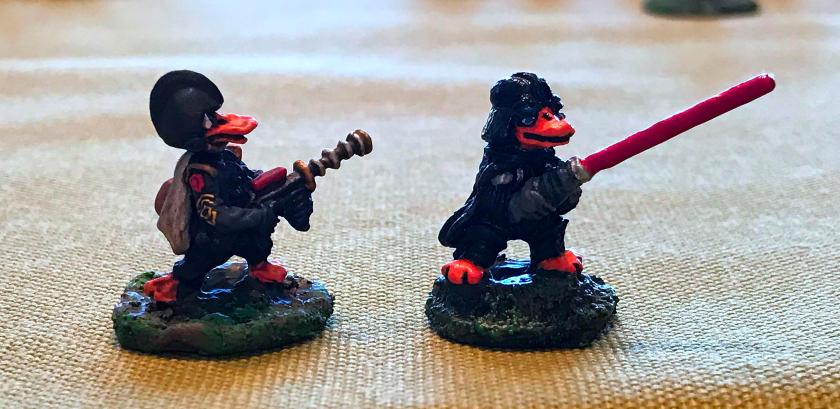









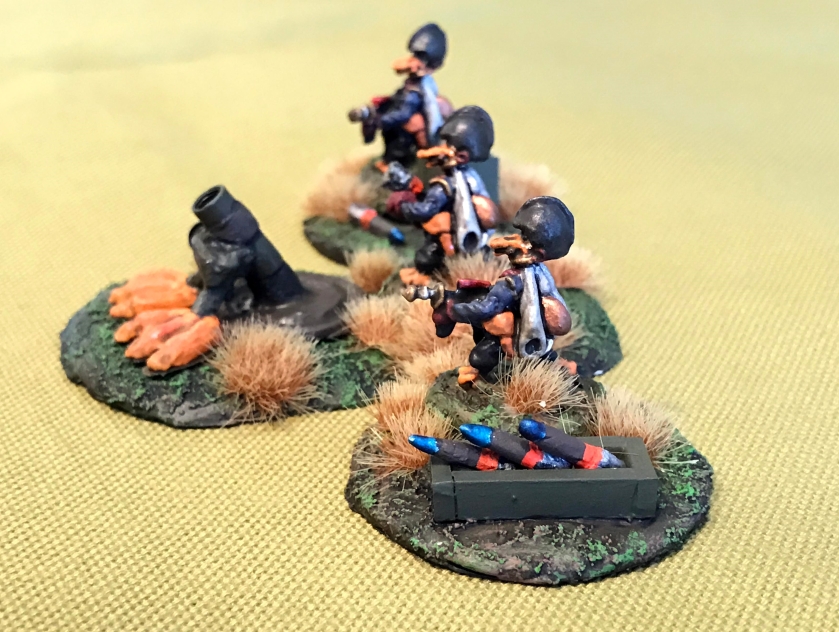




Overall, I am very happy with the unit. I did use Army Painter Quickshade (Soft Tone) which darkened them much more than I expected. The effect was acceptable, but some of my identifying colors were muted.
I will now go into the how-to’s of the making of the unit.
How to Section
- Conversions
All of the figures that I converted were missing the ray gun ends. These were either original casts or my own. I used a jewelry saw, wood carving knives, files, an awl, and an Exacto knife to remove the ray guns and make room for the weapons. Some of the figures lost limbs in this process, but I was able to use green stuff to recreate arms and hands for these figures. I drilled any “amputees” with a pin vise, and used 24 gauge wire as an armature for these.
a. Mortars and Mortarducks
The mortars and mortarducks were the first conversions I attempted for this unit. I envisioned two teams of three – made up of a loader, and two crewducks with ammunition boxes. I made the ammo boxes from Plastruct styrene plastic and special styrene adhesive. I had acquired some Army Painter green stuff, and decided to give it a go for the mortars and rounds. I ended up using my steel sculpting tools, but quickly learned that I needed something different for green stuff, so I got some silicone- tipped tools that worked much better (less stickiness problems). I used paperclip wire with the green stuff for the mortar legs and the rounds. I tried to make a form for the mortar round bases out of 1/8″ plywood, with mixed success. Eventually, I found that correction with an Exacto knife was a good way to go. I made the bases with Apoxie Sculpt and steel washers. In the case of the mortar base, this made sense as I was able to make a strong base with room for the loader using two slightly different washers. The mortars themselves were made with screw extenders, washers, and servo parts for a model airplane. Testors super glue was the means by which I glued the rounds to the loaders and the ammo boxes. Additionally, I found that having some small hobby mirrors from Michaels made the sculpting and assembly process much easier. I decided to leave the two crewducks with their original weapons as the loader conversion had proved to be a lot of work and I did not think it made a difference as I already had the ammo boxes.


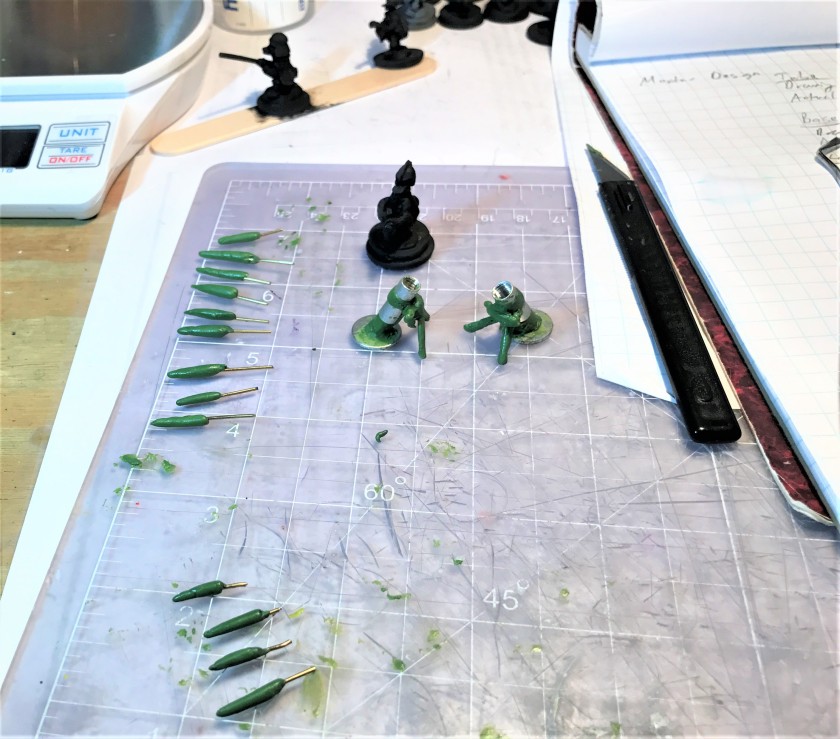






b. Bazookaducks
I wanted the unit to have an anti-tank capability beyond the mortars. I had previously converted some Frinx for this purpose, and decided to do the same for the Star Ducks. The bazookas are from Reaper and came with several other weapons. I basically carved away the ray gun and made the bazookas “fit”. There were amputees in this group, but I think the conversions worked well.
c. Squad Leaders
The squad leaders were simply converted with the same tools. I gave them the War Games Supply Dump blasters from the Dirk Garrison line.
3. Painting and Basing
The biggest challenge with painting was the color orange – I had not used it much before – and it took several iterations of trying different combinations until I found what I liked.
a. Duck Vader
The sequence was as follows:
- Citadel “Imperium Primer” as a brush primer
- Armory “Gloss Black” on helmet
- Craftsmart “Orange” on feet and bill
- Tamiya “Orange” on feet
- Citadel “Ceramite White” on face and tail
- Reaper MSP “Blue Liner” around eyes and pupils
- Vallejo “Aluminum” on light saber beam
- Vallejo “Chrome” on light saber handle
- Vallejo “Steel” on chest details
- Vallejo “Medium Gunship Gray” on gloves
- P3 “Cygnar Blue Highlight” on eyes
- Citadel “The Fang” on eyebrows
- Citadel “Castellan Green” on base
- Citadel “Nuln Oil Gloss” on cape and fingers
- Citadel “Spiritstone Red” on light saber
- P3 “Flesh Wash” on tail
- Highlight cape with Vallejo “Black Grey”
- Vallejo “Black” and “Glazing Medium” on cape and mouth slit
- Deka Lack “Weiss” highlight on tail and face
- Vallejo “Gloss Varnish” on helm
- Army Painter “Anti-shine Varnish” on figure


b. Mortar and mortar rounds
-
The sequence was as follows:
- Citadel “Imperium Primer” as a brush primer
- Armory “Gloss Black” on mortar base
- Vallejo “US Dark Green” on mortar rounds
- Tamiya “Titanium Silver” on mortar round tips and base
- Craftsmart “Orange” on Duckfoot mortar feet
- Tamiya “Orange” on feet
- Citadel “Athonian Camoshade” wash on mortars
- P3 “Sulfuric Yellow” on toes of mortar feet
- Highlight with Tamiya “Orange” on feet
- Citadel “Soulstone Blue” on mortar tip/fuse
- Vallejo “Olive Drab” on mortar and rounds
- Vallejo “Steel” and “Black Metallic” on mortar fins
- Citadel “Fire Dragon Bright” on mortar rounds
- Mounted the mortars and boxes and rounds on bases
- Bases painted with Citadel “Lustrian Undergrowth”
- Bases shaded with Citadel “Seraphim Sepia”
- Bases highlighted with Armory “Musket Brown”
- Bases highlighted with Citadel “Niblet Green”
- Mortar dipped in Army Painter “Quickshade (Soft Tone)”
- Mounted mortar and rounds got coat of Testors “Dullcoat”
c. Star Ducks
- Citadel “Imperium Primer” as a brush primer
- Citadel “Nuln Oil” on figures
- Citadel “Ceramite White” on face and tail
- Citadel “Fire Dragon Bright” on feet and bills
- Reaper MSP “Blue Liner” around eyes and pupils
- Citadel “Soulstone Blue” on eyes
- Citadel “The Fang” on the jacket
- Vallejo “Metallic Black” on helmets and infantry ray guns
- Vallejo “Copper” on fuel tanks
- Americana “Ebony” on trousers
- Vallejo “Black” on mouth slit
- Vallejo “Aluminum” on jet venturi on back
- Vallejo “Gold” and “Chrome” on ray guns
- Polly-S “Goblin Flesh” and Vallejo “Glaze Medium” on holsters
- Vallejo “German Grey” on ammo pouches
- Vallejo “Signal Red” on ray gun scopes
- Vallejo “Gold”, “Chrome”, “Copper”, and “Signal Red” on WSD blasters
- Different glove colors on lapels, helmet buttons, and gloves: Platoon Sergeant – Vallejo Metallic “Arctic Blue”; 1st Squad – Citadel “Ushabti Bone”; 2nd Squad – Americana “Bahama Blue”; 3rd Squad – Americana “Apple Green”; Bazookaducks – Polly-S “Demon Deep Red”; Mortarducks – Americana “Dioxazine Purple”
- Armory “Musket Brown” and Vallejo “Neutral Grey” on cigars
- Vallejo “Black” on bill vents
- Vallejo “Light Orange” and “Glaze Medium” as glaze on bills and feet
- Vallejo “US Dark Green” on bazookas
- Citadel “Athonian Camoshade” wash on bazookas
- Milliput (yellow) on bases
- Bases painted with Citadel “Lustrian Undergrowth”
- Bases shaded with Citadel “Seraphim Sepia”
- Bases highlighted with Armory “Musket Brown”
- Bases highlighted with Citadel “Niblet Green”
- Figures dipped in Army Painter “Quickshade (Soft Tone)”
- Figures coated with an application of Testors “Dullcoat”
- Used various Army Painter tufts and meadow flowers on bases to designate teams




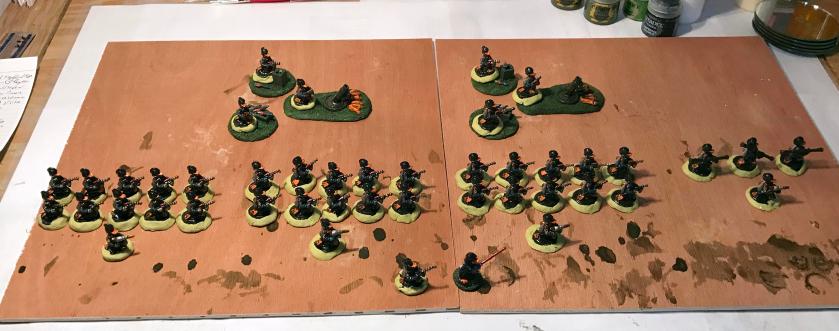
To wrap up, I am very happy that the unit is done. I am on the fence as to the use of the Army Painter “Quickshade” – the figures are darker and well-shaded, and should be well protected, but some details are obscured. I enjoyed my new Vallejo products and found that they really worked well. I also learned that orange as a color requires multiple applications and glazing to work well.
I learned much that I can use for future projects, and I hope that you enjoyed this blog entry.
Please leave comments and feedback! Thanks!
